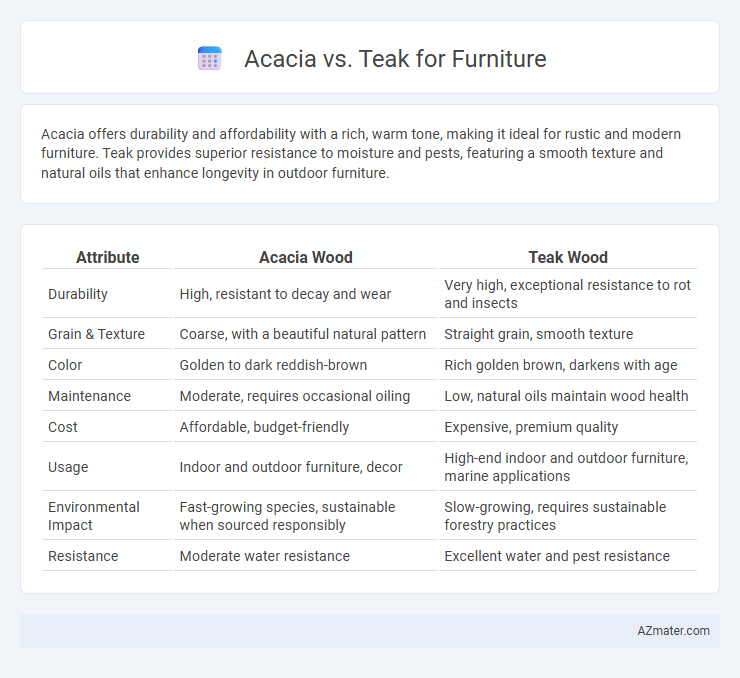Acacia offers durability and affordability with a rich, warm tone, making it ideal for rustic and modern furniture. Teak provides superior resistance to moisture and pests, featuring a smooth texture and natural oils that enhance longevity in outdoor furniture.
Table of Comparison
| Attribute | Acacia Wood | Teak Wood |
|---|---|---|
| Durability | High, resistant to decay and wear | Very high, exceptional resistance to rot and insects |
| Grain & Texture | Coarse, with a beautiful natural pattern | Straight grain, smooth texture |
| Color | Golden to dark reddish-brown | Rich golden brown, darkens with age |
| Maintenance | Moderate, requires occasional oiling | Low, natural oils maintain wood health |
| Cost | Affordable, budget-friendly | Expensive, premium quality |
| Usage | Indoor and outdoor furniture, decor | High-end indoor and outdoor furniture, marine applications |
| Environmental Impact | Fast-growing species, sustainable when sourced responsibly | Slow-growing, requires sustainable forestry practices |
| Resistance | Moderate water resistance | Excellent water and pest resistance |
Introduction to Acacia and Teak Wood
Acacia wood, known for its durability and rich grain patterns, is a popular choice for both indoor and outdoor furniture due to its natural resistance to water and insects. Teak wood is highly valued for its exceptional hardness, golden-brown color, and outstanding resistance to decay and weather, making it ideal for high-end, long-lasting furniture pieces. Both woods offer unique aesthetics and strength, with acacia providing a more affordable option while teak remains a premium choice prized for its longevity and classic appearance.
Origin and Botanical Characteristics
Acacia wood originates primarily from Australia, Africa, and Southeast Asia, characterized by its dense, hard texture and fine, uniform grain, which makes it highly durable for furniture. Teak, native to South and Southeast Asia, especially Myanmar, features natural oils that provide exceptional water resistance and a rich golden-brown hue with a straight grain pattern. Both woods belong to different botanical families--Acacia from Fabaceae and Teak from Lamiaceae--impacting their growth habits and wood properties used in furniture making.
Durability and Strength Comparison
Acacia wood offers high durability and resistance to moisture, making it ideal for outdoor furniture, while teak is renowned for its exceptional strength and natural oils that protect against decay and insect damage. Teak's dense grain structure provides superior hardness, contributing to its long lifespan even under harsh weather conditions. Acacia is more affordable and sustainable but generally less resilient than teak in extreme environments.
Resistance to Water and Weather
Acacia wood offers moderate resistance to water and weather due to its dense grain and natural oils, making it suitable for outdoor furniture with proper maintenance. Teak wood excels in durability and weather resistance thanks to its high oil content and tight grain, providing superior protection against moisture, UV rays, and temperature fluctuations. Both woods benefit from regular sealing, but teak generally requires less upkeep and performs better in harsh environmental conditions.
Aesthetic Appeal: Color and Grain Patterns
Acacia furniture showcases a rich variety of warm hues, ranging from golden browns to deep reddish tones, complemented by striking, swirling grain patterns that create a natural, rustic aesthetic. Teak is renowned for its smooth texture and consistent golden-brown color that darkens elegantly over time, featuring straight, tight grain patterns that lend a sophisticated and timeless look. Both woods enhance interior spaces with unique visual qualities: Acacia offers vibrant, contrasting grains for bold statements, while Teak provides subtle, uniform beauty ideal for classic and contemporary furniture designs.
Sustainability and Environmental Impact
Acacia wood is known for its rapid growth and abundance, making it a more sustainable option compared to teak, which grows slower and is often sourced from endangered forests. Teak forests face significant deforestation pressures, whereas acacia plantations can be managed with lower ecological disruption and faster replenishment rates. Choosing acacia furniture reduces carbon footprint due to shorter harvest cycles and less habitat destruction, promoting eco-friendly practices in the wood furniture industry.
Workability and Maintenance Requirements
Acacia wood offers excellent workability with its smooth grain and moderate density, making it easier to cut, shape, and finish compared to the denser and harder teak. Teak furniture requires less frequent maintenance due to its natural oils that resist moisture, pests, and decay, whereas Acacia needs regular sealing and oiling to prevent cracking and warping. Both woods provide durability, but teak's superior weather resistance results in lower upkeep, making it ideal for outdoor furniture with less maintenance effort.
Cost and Availability
Acacia furniture is generally more affordable than teak, making it a popular choice for budget-conscious consumers. Teak, harvested primarily from Southeast Asia, tends to be more expensive due to its durability and high oil content, which increases resistance to weather and pests. Availability of acacia is widespread as it grows in various regions, whereas teak supply is more limited and regulated to prevent overharvesting.
Common Furniture Applications
Acacia wood is commonly used for outdoor furniture, dining tables, and benches due to its natural durability and resistance to moisture, making it ideal for patios and gardens. Teak, prized for its high oil content and strength, dominates luxury indoor furniture such as chairs, cabinets, and beds, offering superior resistance to decay and insects. Both woods offer distinct advantages, with acacia favored for its affordability and sustainability, while teak remains the premium choice for long-lasting, high-end furniture pieces.
Acacia vs Teak: Which Is Best for Your Needs?
Acacia wood offers exceptional durability and resistance to moisture, making it ideal for outdoor furniture and budget-conscious buyers seeking sustainable options. Teak is renowned for its natural oils and dense grain, providing superior weather resistance and an elegant finish perfect for high-end indoor or outdoor pieces. Choosing between Acacia and Teak depends on balancing cost, upkeep, and aesthetic preferences for your specific furniture needs.

Infographic: Acacia vs Teak for Furniture
 azmater.com
azmater.com